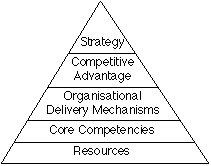Capabilities and Competences
Capability-based strategies are based on the notion that internal resources and core competencies derived from distinctive capabilities provide the strategy platform that underlies a firm's long-term profitability. Evaluation of these capabilities begins with a company capability profile, which examines a company's strengths and weaknesses in four key areas:
- managerial
- marketing
- financial
- technical
Then a SWOT analysis is carried out to determine whether the company has the strengths necessary to deal with the specific forces in the external environment. This analysis enables managers to identify:
- external threats and opportunities, and
- distinct competencies that can ward off the threats and compensate for weaknesses.
The picture identified by the SWOT analysis helps to suggest which type of strategy, or strategic thrust the firm should use to gain competitive advantage.
Stalk, Evans and Schulman (1992) have identified four principles that serve as guidelines to achieving capability-based competition:
- Corporate strategy does not depend on products or markets but on business processes.
- Key strategic processes are needed to consistently provide superior value to the customer.
- Investment is made in capability, not functions or SBUs.
- The CEO must champion the capability-based strategy.
Capability-based strategies, sometimes referred to as the resource-based view of the firm, are determined by (a) those internal resources and capabilities that provide the platform for the firm's strategy and (b) those resources and capabilities that are the primary source of profit for the firm. A key management function is to identify what resource gaps need to be filled in order to maintain a competitive edge where these capabilities are required.

Several levels can be established in defining the firm's overall strategy platform (see figure).
At the bottom of the pyramid are the basic resources a firm has compiled over time. They can be categorised as technical factors, competitive factors, managerial factors, and financial factors.
Core competencies can be defined as the unique combination of the resources and experiences of a particular firm. It takes time to build these core competencies and they are difficult to imitate. Critical to sustaining these core competencies are their:
- Durability - their life span is longer than individual product or technology life-cycles, as are the life spans of resources used to generate them, including people.
- Intransparency - it is difficult for competitors to imitate these competencies quickly.
- Immobility - these capabilities and resources are difficult to transfer.
References
- Rowe, Mason, Dickel, Mann, Mockler; "Strategic Management: a methodological approach". 4th Edition, 1994. Addison-Wesley. Reading Mass.
- Stalk, G Jnr., Evans, P. and Schulman, LE. 1992. "Competing on capabilities: the new rules of corporate strategy". Harvard Business Review, Vol.70, No. 2, March-April, pp. 57-70.
- Prahalad, CK. and Hamel, G. 1990. "The Core Competence of the Corporation". Harvard Business Review, May-June, pp. 79-91.









